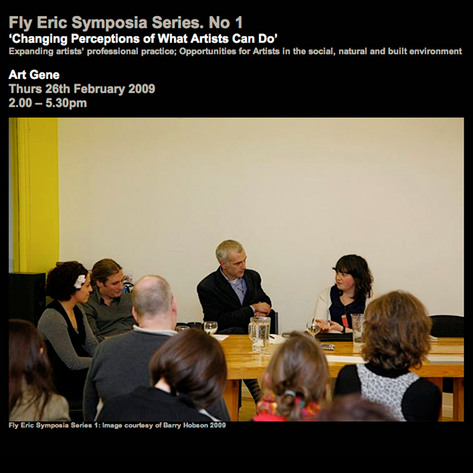What we do
Event Name: Changing perceptions of what artists can doVenue/Location: Art Gene, Cumbria
Date: 26th February 2009
Fly Eric (Symposia Series), Art Gene
Chair/Other Speakers:
Mitra Memarzia (Chair), Maddi Nicholson, Verity-Jane Keefe, Charlie MacKeith
A one day symposium aspiring to expand artists' professional practice and consider opportunities for artists in the social, natural and built environment
Symposia Report (Extract):
“A bit like a boyband” is how Maddi Nicholson, co-founder of Art Gene in Barrow and today’s host, describes the aeronautically named Fly Eric – a network of artist-focused organisations in the Northwest of England, led by three galleries which were brought together by the Arts Council; Manchester’s Castlefield Gallery, Art Gene and Storey Gallery in Lancaster. Collectively these organisations have developed a number of initiatives, including a cross-gallery educational project and a symposia series, of which today’s event, Changing Perceptions of What Artists Can Do is the first.
I am mentally assigning each gallery director with a Take That alter ego, when the event takes off. It is piloted by the reassuringly composed Mitra Memarzia, a Birmingham-based multi-media artist who, amongst other things, sits on the board of directors for AN - the Artist Information Company, and is advisor to their Artists Interaction and Representation scheme (AIR).
Memarzia describes our flight path as “methodologies for changing perceptions of what artists can do”. Yet, to whom these perceptions belong is initially unclear; is it developers? Local authorities? Members of the public? The artworld?
As the event unfolds it becomes evident that the answer lies closer to home. The first speaker, David Cotterrell, presents a coming-of-age story, which plots his journey from early, romantic aspirations to become Cold War Britain’s last portrait painter, to his current practice as a multi-media artist and consultant to urban regeneration master plans and public art policy. The pivotal moment in Cotterrell’s career occurs during his second year at art school, when he realises that his focus on painting - a medium in which he is competent but not exceptional – has limited his ability to communicate his increasingly politicised ideas about art and society, and that by “sacrificing a broad audience for an autonomous voice” he has literally painted himself into a corner. His solution is to embark on a year’s residency in Canada, where anonymity dispels his fear of failure and grants him the confidence to begin again from scratch. He emerges a different type of artist, lacking the core practice so important to his earlier incarnation, but in possession of a new understanding of “what an artist can be”.
And so begins a prolific career, encompassing such diverse projects as the construction of a transportable, floating property, inspired by Rousseau’s Discourse on Inequality, numerous gallery-based installations, a film constructed from CCTV footage of the London underground, and the propagation of an urban myth in inner-city Birmingham. Parallel to these are roles as lead artist on urban design teams, war artist in Afghanistan, and artist researcher in Shanghai.
Interestingly, the eclectic nature of Cotterrell’s practice and his refusal to be pigeonholed as a ‘public artist’ are contradicted by a self-conscious need for boundaries. Whilst this could be viewed as an agoraphobic response to the loss of painting’s material restraints, the process of setting margins is a useful strategy for working with unfamiliar materials and contexts. Likewise, the artist exploits his lack of professional status as a way to eschew the macro view of the war correspondent or utopian vision of the urban planner, in favour of the “messy reality of the subjective view”. Cotterell sees his role as that of “curious individual” and is emphatic that artists resist the temptation to professionalise their practice. He suggests that artists can only effect change through adopting the role of outsider and, only half jokingly, proposes a limit on the number of times that an artist can sit within an urban design team.
Text by Elaine Speight (full transcript available here)
Share:
Twitter / Facebook / Pinterest
